
endangered
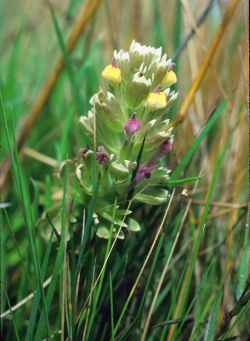
Pink Johnny-nip (Castilleja ambigua var. insalutata). Point Joe, Monterey Peninsula, Monterey County, CA, 29 June 1992. Copyright © 1992 J. Mark Egger.
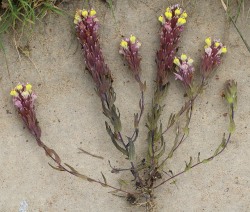
Pink Johnny-nip (Castilleja ambigua var. insalutata), voucher specimen (WTU). Along trail to Machine Gun Flat, Fort Ord National Monument, Monterey County, CA, 11 May 2016. Copyright © 2016 J. Mark Egger.
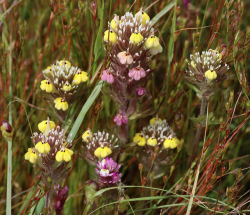
Pink Johnny-nip (Castilleja ambigua var. insalutata). Along trail to Machine Gun Flat, Fort Ord National Monument, Monterey County, CA, 11 May 2016. Copyright © 2016 J. Mark Egger.
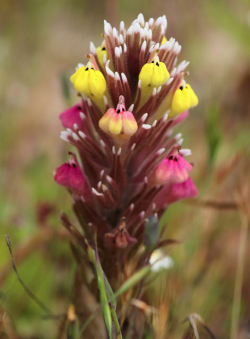
Pink Johnny-nip (Castilleja ambigua var. insalutata). Along trail to Machine Gun Flat, Fort Ord National Monument, Monterey County, CA, 11 May 2016. Copyright © 2016 J. Mark Egger.
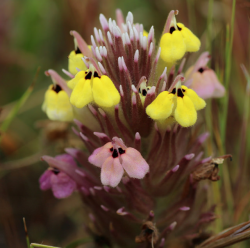
Pink Johnny-nip (Castilleja ambigua var. insalutata). Along trail to Machine Gun Flat, Fort Ord National Monument, Monterey County, CA, 11 May 2016. Copyright © 2016 J. Mark Egger.
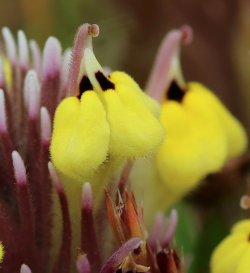
Pink Johnny-nip (Castilleja ambigua var. insalutata). Along trail to Machine Gun Flat, Fort Ord National Monument, Monterey County, CA, 11 May 2016. Copyright © 2016 J. Mark Egger.



This fact sheet was prepared by Dylan M. Neubauer under award NA04N0S4200074 from the National Oceanic and Atmospheric Administration (NOAA), U.S. Department of Commerce (DOC). The statements, findings, conclusions, and recommendations are those of the authors and do not necessarily reflect the views of the NOAA or the DOC.
© Copyright 2006, Elkhorn Slough Coastal Training Program
Last updated: Dec 2, 2017 21:50
Common Names - pink Johnny-nip
Family - Orobanchaceae (Broomrape Family)
State Status - none
Federal Status - none
Habitat
Coastal prairie, scrub on coastal bluffs; < 100 m (CNPS 2012, Wetherwax et al. 2012).
Key Characteristics
Annual herb, not fleshy or occasionally slightly fleshy, 10–30 cm tall, puberulent; stems much-branched from base, decumbent; leaves 10–50 mm long, lanceolate to oblong; lobes 0–5; inflorescence 3–12 cm long, often dense; bracts 15–25 mm long, oblong to ovate; bract tips acute or rounded, white, becoming pink to ± rose-purple with age, lobes 3–9, central lobe generally rounded; calyx 12–20 mm, divided 1/2 abaxially and on sides, 2/3 adaxially, lobes linear; corolla beak 4–5 mm, ± straight, puberulent, pale salmon-pink to ± rose-purple; corolla lower lip 3–4 mm long, pale to bright yellow, becoming white, pale yellow, pale pink, or pink-purple with age, lower lip teeth 1.5–2 mm long, often with a blackish spot at base; corolla pouches 3–7 mm wide, 1–2 mm deep, generally purple-dotted at base; stigma generally ± exserted (Wetherwax et al. 2012, modified by Egger 2017).
The range of widespread C. a. var. ambigua (with bract tips white [not yellow as described in Jepson eFlora], lower lip yellow, lower lip teeth ± 1 mm long) overlaps with that of C. a. var. insalutata. Possible intergrades between the two varieties have been observed at Bean Hollow State Park on the San Mateo County coast (Egger, Flickr site comment).
Flowering Period
May to August
Global Distribution
Endemic to central coastal California (cCO) in Monterey and San Luis Obispo counties; historic collections from San Mateo County likely represent this taxon.
Reference Population
Fort Ord National Monument (Monterey County)
Discussion
The Jepson eFlora calls Castilleja ambigua “highly variable and difficult; many local ± ecological forms; needs study” (Wetherwax et al. 2012). J. Mark Egger (2012) describes Castilleja ambigua as a “complex and polymorphic species.” In his 1927 revision of the genus Orthocarpus, David D. Keck states that, due to its variability, the species is the “most difficult within the genus for the taxonomist to handle. ... Each colony seems to produce a unique form of its own. Many of these are certainly ecological for the species grows in various saline soils along the coast and some of the plants actually grow in the salt water” (Keck 1927).
George Bentham described Orthocarpus castillejoides in 1835 from a collection by David Douglas “probably” from the “San Francisco area.” In 1925, Willis L. Jepson described O. c. var. insalutatus based on his type (21110) collected on 8 August 1896 in Pacific Grove, Monterey County. He distinguished his variety from the typical form in the following ways: “Leaves and bracts broader and shorter; bracts mostly 3-parted, the middle lobe broad and very blunt; sacs of lower corolla-lip broad and very protuberant.” Jepson did not mention bract-tip color or corolla color.
Keck (1927) divided O. castillejoides into three varieties—var. typicus, var. humboldtiensis, and var. insalutatus. The latter two he recognized “because of their geographic isolation and the constancy and the importance of their characters.” Keck distinguished var. insalutatus from var. typicus by its oval or elliptical leaves (vs. widely lanceolate) and its wide, subcapitate inflorescence (vs. terete). He cited Pacific Grove, Monterey, and “between Point Pinos and Pacific Grove” as localities.
Robert F. Hoover’s 1970 Vascular Plants of San Luis Obispo County only lists O. castillejoides. Hoover states that the plant inhabits “[m]oist places on northern coast” at Piedras Blancas (Eastwood & Howell 5986) and a “hilltop south of Arroyo de la Cruz (7947).” In 1997, the Piedras Blancas specimen (UC 886452) was annotated as C. a. subsp. ambigua, and the Arroyo de la Cruz specimen (JEPS 7430) as C. a. subsp. insalutata (CCH 2017). San Luis Obispo plants require further study.
In their 1991 morphological and cytological reevaluation of subtribe Castillejinae, T.-I. Chuang and Lawrence Heckard placed O. c. var. insalutatus, and 11 other annuals formerly included in the previously polyphyletic genus Orthocarpus Nutt., into genus Castilleja, subgenus Colacus, section Oncorhynchus, and proposed a new combination with the resurrected Castilleja ambigua Hook. & Arn.—C. a. subsp. insalutata (Jepson) Chuang & Heckard (Egger et al. 2012).
In 2008, to establish consistency within the genus, Egger renamed the taxon Castilleja ambigua var. insalutata. Egger (2008) defines “varieties as diverging systems of natural populations within a presumed progenitor species and characterized by relatively minor but reasonably consistent patterns of morphological divergence, combined with varying degrees and combinations of ecological and/or geographical partitioning.” He describes the nominate variety as “more adaptable and far more widespread” than the other two varieties, “occurring in a number of complex and variable forms both along the coast and somewhat sporadically [in] mesic to somewhat xeric inland grasslands.” Also in 2008, a molecular phylogenetic study (Tank and Olmstead) confirmed that annuals of section Onchrhynchus belong with Castilleja. In 2012, Egger et al. described C. a. var. meadii—a Napa County endemic that occurs in vernal pools on volcanic substrates within chaparral.
Conservation and Threats
Northwestern San Luis Obispo County ostensibly contains four occurrences of C. a. var. insalutata, and, as of 2017, two have been observed within the last five years. Lands to the east of Highway 1 are owned by the Hearst Corporation and have been subject to grazing for more than a century, therefore grazing may pose a threat. Several plants were photographed in 2006 near Piedras Blancas on California State Parks/Caltrans property. Threats on Parks land potentially include recreational use, erosion, and invasive species.
The conservation outlook for C. a. var. insalutata in Monterey County is poor. Of the nine occurrences, two are on California Department of Parks and Recreation Point Lobos State Natural Reserve. These two are based on historic collections and have not been relocated. Two City of Monterey–owned parks contain the sites of two other occurrences based on old collections, neither of which have not been relocated. A “Spruance Meadow” occurrence has not been observed for ca. 20 years and requires fieldwork, and another from the Point Joe area was photographed by J. Mark Egger in 1992 (Flickr). The Bird Rock occurrence, with ownership unknown, was observed in 2005, but not in 2008. The Pacific Grove occurrence is based on historic collections and has not been relocated. The Fort Ord National Monument occurrence may be the only extant location for this taxon in Monterey County. It was last observed there in 2016 (Egger photos, Flickr). Threats include invasive species and changes in hydrology.
Three historic collections from Moss Beach and Burlingame in San Mateo County (Brandegee s.n., Keck 1453, Pennell & Keck 25427) probably represent Castilleja ambigua var. insalutata. After conducting fieldwork in the Burlingame area ca. 2002, Egger concluded that any populations in that locality were likely extirpated (Egger, personal communication, 2017).
References
Atsatt, P. R. 1966. The population biology of annual grassland hemiparasites. II. Reproductive patterns in Orthocarpus. Evolution 24:598–612.
California Native Plant Society (CNPS), Rare Plant Program. 2013. Castilleja ambigua var. insalutata. Inventory of Rare and Endangered Plants (online edition, v8-03 0.39). California Native Plant Society, Sacramento, CA. http://www.rareplants.cnps.org/detail/3391.html [acc. 29 November 2017].
California Natural Diversity Database (CNDDB). 2017. [Internet]. California Department of Fish and Wildlife [acc. 29 November 2017].
Chuang, T. I. and L. R. Heckard. 1982. Chromosome numbers of Orthocarpus and related monotypic genera (Scrophulariaceae: subtribe Castillejinae). Brittonia 34:89–101.
Chuang, T. I. and L. R. Heckard. 1991. Generic realignment and synopsis of subtribe Castillejinae (Scrophulariaceae—Tribe Pediculareae).
Consortium of California Herbaria (CCH). 2017. [Internet]. [acc. 29 November 2017].
Egger, J. M. Comment on Eric Hunt photo on Flickr. https://www.flickr.com/photos/ericinsf/3802068589/in/photolist-6MYAwH-6N6N9E [acc. 2 December 2017].
Egger, J. M. 1994. New natural hybrid combinations and comments on interpretation of hybrid populations in Castilleja (Scrophulariaceae). Phytologia 77:381–389.
Egger, J. M. 2008. Nomenclatural changes and selected lectotypifications in Castilleja (Orobanchaceae). Phytologia 90(1):63–82. http://www.phytologia.org/uploads/2/3/4/2/23422706/90163-82eggercastilleja.pdf [acc. 29 November 2017].
Egger, J. M., J. A. Ruygt, and D. C. Tank. 2012. Castilleja ambigua var. meadii (Orobanchaceae): a new variety from Napa County, California. Phytoneuron 2012-68:1–12.
Haydu, K. 2012. Mapping plant biodiversity hotspots at the county scale: a new tool for establishing resource conservation strategies. Master's Thesis, California Polytechnic State University, San Luis Obispo, CA. http://digitalcommons.calpoly.edu/cgi/viewcontent.cgi?article=1792&context=theses [acc. 28 November 2017].
Hoover, R. F. 1970. The vascular plants of San Luis Obispo County, California. University of California Press, Berkeley, CA.
Howitt, B. F. and J. T. Howell. 1964. The vascular plants of Monterey County, California. The Wasmann Journal of Biology 22(1).
Jepson, W. L. 1925. Manual of the flowering plants of California. University of California Press, Berkeley, CA.
Keck, D. D. 1927. A revision of the genus Orthocarpus. Proceedings of the California Academy of Sciences, Fourth Series, 16(17):517–571.
Keil, D. and M. McLeod. 1989. Rare plants in the Arroyo de la Cruz Endemic Area, San Luis Obispo County, California, in Conservation and management of rare and endangered plants: proceedings from a conference of the California Native Plant Society, Thomas S. Elias (ed.). California Native Plant Society, Sacramento, CA.
Matthews, M. A. and M. Mitchell. 2015. The plants of Monterey County: an illustrated field key, Second Edition. Monterey Bay Chapter, California Native Plant Society, Carmel, CA.
Tank, D. C. and R. G. Olmstead. 2008. From annuals to perennials: phylogeny of subtribe Castillejinae (Orobanchaceae). American Journal of Botany 95(5):608–625.
Tank, D. C. , J. M. Egger, and R. G. Olmstead. 2009. Phylogenetic classification of Subtribe Castillejinae (Orobanchaceae). Systematic Botany 34(1):182–197.
M. Wetherwax, T. I. Chuang, and L. R. Heckard. 2012. Castilleja ambigua subsp. insalutata, in Jepson Flora Project (eds.) Jepson eFlora, http://ucjeps.berkeley.edu/eflora/eflora_display.php?tid=49734 [acc. 29 November 2017].
Reviewer
J. Mark Egger, author of the Castilleja treatment in Vol. 17 of the Flora of North America (unpublished).
